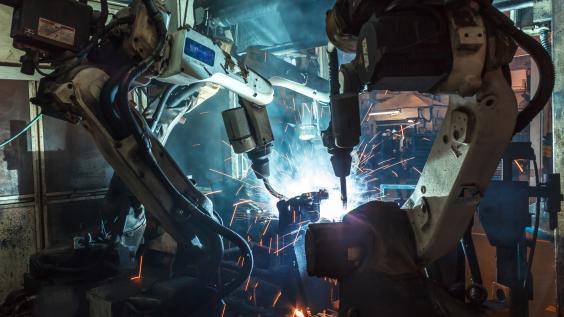
Table of Contents
Author(s)
Dagobert Brito
Baker Institute Rice Faculty Scholar | Professor EmeritusShare this Publication
- Download PDF
- Print This Publication
- Cite This Publication Copy Citation
Brito, Dagobert and Robert F. Curl. 2020. Automation Does Not Kill Jobs. It Increases Inequality. Baker Institute Report no. 11.06.20. Rice University’s Baker Institute for Public Policy, Houston, Texas.
For a more extensive look at the research addressed below, read the working paper here.
Abstract
The authors have developed a model of the effects of automation upon an economy similar to the U.S. The model predicts that the most important consequence of automation is to lower the real wages of medium-skilled and low-skilled workers. Data covering the period 1984 to 2016 demonstrate, as the model predicts, that the share of these workers in domestic production has steadily, if somewhat noisily declined.1
Introduction
The first chapter of Adam Smith’s seminal work,2 The Wealth of Nations, is devoted to a discussion of the division of labor in production. In that chapter he discusses the division of labor in a pin factory where 10 men produce twelve pounds of pins a day. This is 48,000 pins or 4,800 pins per person per day. Smith notes that one person working alone could not produce 48 pins a day. The division of labor greatly increased production and replaced skilled labor with unskilled labor. In 1776, the year Wealth of Nations was published, James Watt introduced his steam engine. Until the late 18th century, all goods were created and transported by the brains of humans and the muscles of humans and animals. Then machines began replacing the muscles of humans and animals. Over the next 150 years, the Industrial Revolution transformed the economies and social structures of the Western world. For most of that period, labor struggled to overcome the displacements caused by the new technology. The enormous gains in labor productivity and the resulting growth of wealth came to be shared with labor. Now automation is replacing the brains of humans in the creation and transport of goods.
Automation has become a major occupation of the minds of economists. In roughly the last decade, this subject has attracted the attention of a number of workers and papers expressing a variety of opinions ranging from widespread unemployment caused by automation to a new age of economic growth with full employment.
There is general agreement that there are three possible ways in which automation affects the economy and thus society:
- Increasing the productivity of workers by augmentation
- Creation of new and presumably better jobs by creation of new industries
- Displacement of workers by substitution
A community of people who are interested in this subject appear to be focused on job loss by automation. In particular, the work3 of Carl Benedikt Frey and Michael Osborne predicted that up to 47 percent of jobs in the U.S. could be lost to automation. The community argues that Frey and Osborne must wrong because automation has not manifested itself as lost jobs.4 We argue that this fixation upon lost jobs is leading the field astray.
Instead of lost jobs, our model assumes full employment, but with automation displacing a fraction of the workers without eliminating the job. These displaced workers find new jobs because the economy can accommodate more workers at lower pay. A principal effect of automation is to fix the wages of the lowest-paid 50 percent of workers (Type C) and next 40 percent of workers (Type B) to the marginal cost of automation for each type of worker. The effect of automation is not job loss, but lowered wages for these workers. Because new capital is coming into the economy to pay for the automation while other factors remain constant, GDP grows.
Supporting this conclusion, the U.S. economy is demonstrating that the median wage is not keeping up with the growth of the GDP. We note that prior to the arrival of Covid-19 the U.S. economy was booming with low unemployment but the wages of average workers were barely rising. This situation is best illustrated by using Federal Reserve data.5 This phenomenon is illustrated in Figure 1 below.
This is what our model predicts: economic expansion with most workers not sharing in the economic growth.
Figure 1 — U.S. Median Income per Household Divided by per Capita GDP6
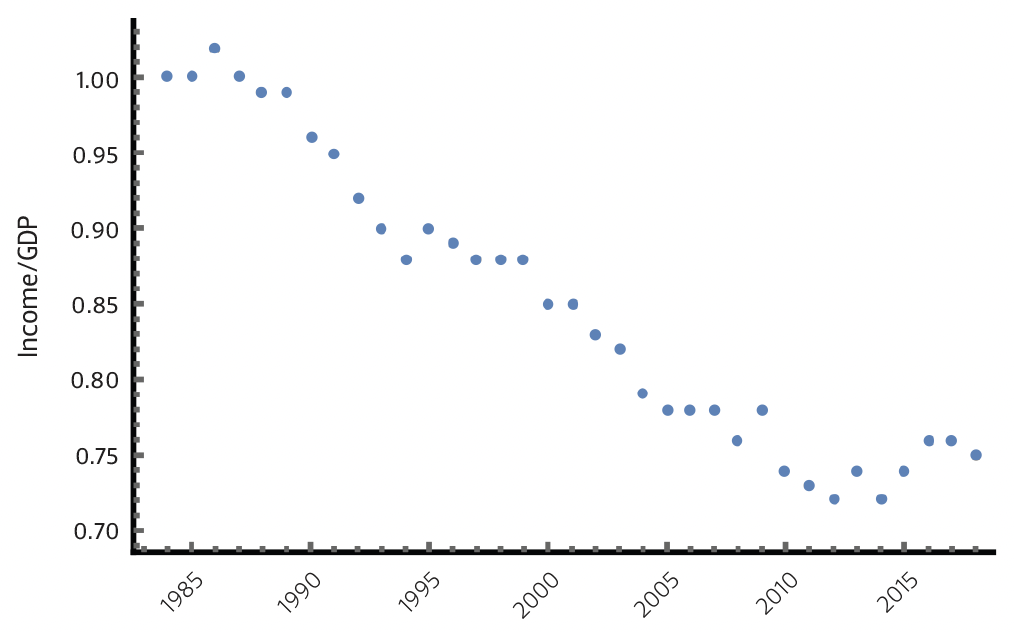
The cause for concern is not job loss, but increasing inequality. In the 19th century, some labor economists—and Karl Marx—argued that the wages of workers were set by the reserve army of the unemployed. If the demand for labor increased, the result would be an increase in employment from the army of unemployed workers rather than an increase in wages. The current situation is similar. The wages of workers are set by the cost of robot substitutes.
To set the stage, we define a “robot” (which might be just a computer program) as the amount of automation sufficient to displace a person. However, typically the job does not disappear upon automation; rather, typically some but not all of the tasks will be automated and some of the workers employed in the job will be displaced. There are two questions that have to be addressed: 1) what will be the impact of technical change on the distribution of income as robots replace workers in the performance of some tasks; 2) will it be possible to train the displaced workers for highly skilled jobs that cannot be performed by robots.
As robots are introduced, workers are affected in different ways. Robots are substitutes for some of the tasks of workers, with the result that the wages of all workers of that type become linked to the cost of robots. Their income drops in step with the cost of automation. For highly paid (Type A) workers, robots are a complementary factor in production and their wages go up as they become more productive. To address these questions in a way that is useful for policy, it is necessary to have data as to the structure of jobs in the economy. We obtain the necessary information from the results of Frey and Osborne.7,8 We assume that, for a particular job, Frey and Osborne in their probabilities of automation capture the effort-weighted fraction of the tasks that will be eliminated. That job is likely to continue to exist, but employs fewer workers and the nature of the job may change.
As an example, a librarian must check books in and out of libraries, teach library patrons basic computer skills, review and evaluate materials for purchase, search standard reference materials, keep up-to-date records of circulation and materials, maintain inventory, and correct cataloging errors. Some, but not all, of these tasks can be automated. It does not seem possible to automate all the tasks performed by a librarian, but it is possible to reduce the number of librarians needed by automating some of the tasks a librarian performs.
The second important question is whether it will be possible to train workers to do the high paying jobs of the future. To many, the answer to this question carries the baggage of the past. The division of labor that Adam Smith describes meant that a job that required a skilled worker could be disaggregated into a set of tasks that could be performed by a set of semi-skilled laborers and the educational system was able to educate the working population to perform the tasks required. These jobs were high paying mostly where the workers were able to organize and bargain for higher wages. In the United States, higher wages in manufacturing disappeared when manufacturers moved to states that had right-to-work laws.9
We use the work of Frey and Osborne to model workers. We assume that labor is heterogeneous and divide the labor force by skill groups: highly skilled workers (top 10 percent of wages), medium-skilled workers (middle 40 percent) and low-skilled workers (bottom 50 percent). We designate these respectively as Type A workers, Type B workers, and Type C workers. Each type of worker can perform a bundle of tasks. For simplicity, we assume that the bundles are different and that among them the three bundles include all possible tasks. The production of any good requires a set of tasks so the firm must hire enough of each type of worker to produce the good. The wage of a particular type of worker depends upon the market that he is in. A job will be high paying only if the skills required for it are scarce. You can train displaced workers for the new jobs—assuming they can be trained to do these jobs—but they will not be high paying unless the skills required are scarce. It does not matter whether the skill is valuable; to be high paying, the skill must be scarce. This implies that a job will not be high paying unless it requires abilities that are scarce. If not, the quasi-rents will be eliminated as more workers acquire the necessary skills to compete for those jobs.
There are many very valuable and essential tasks, such as caring for the elderly, collecting garbage, or working in meat processing plants, that are not well paid and the wages earned do not reflect the social value of the tasks. This is because the skills required to perform these tasks are not scarce.
The Model
In order to explore the consequences of automation, we have developed a simple macro-economic model that incorporates the findings of Frey and Osborne using the task-oriented structure of McKinsey & Co.10 Macroeconomic models require many parameters, most of which are usually unknown. The theoretical underpinning of macroeconomics is general equilibrium theory, but, while the theory is beautiful, its application is difficult. Our central concern is how automation affects the economic well-being of workers. Therefore, our model avoids the difficult subjects of the creation of capital and savings by just assuming that capital can be leased at some reasonable rate.
We use the 1980 U.S. economy, which we assumed to be without automation, to calculate the basic parameters for our model.11 Our work is solely concerned with production in the consumption sector. We assume that the labor force is fixed at the 1980 level. We calculate how production is shared in a competitive market, ignoring governmental actions such as taxes and transfer payments.
Our model assumes that robots can replace medium- and low-skilled workers, but not high-skilled workers because they have special abilities. Our model breaks the economy into many firms, each making a single good. These firms differ only in the cost of the automation to replace middle-skilled workers and low-skilled workers. This causes the firms to belong to one of three groups, which we call sectors. In Sector 1, the firms have substituted robots for all replaceable tasks of both low-skilled (Type C) and medium-skilled (Type B) workers. In Sector 2, there is no displacement of Type C workers, but Type B workers have been displaced in all the tasks that can be automated. In Sector 3, no tasks of either type have been automated and no robots are used.
Shares of Production
Substitution of workers makes capital’s share in production grow and the shares of the substituted workers decline as robots displace workers. This is shown in Figure 2 below. The share of high-skilled workers grows with growth of the economy caused by capital investment in automation. In this growing economy, high-skilled workers have a higher marginal product and are also in higher demand. In all the figures below, the abscissa is the percentage of all A workers employed in Sector 1, in which all tasks of both B and C workers that can be automated have been automated. Therefore, this abscissa can range from 0 to 100.
Figure 2 — How Automation Affects the Shares of the Four Factors of Our Model
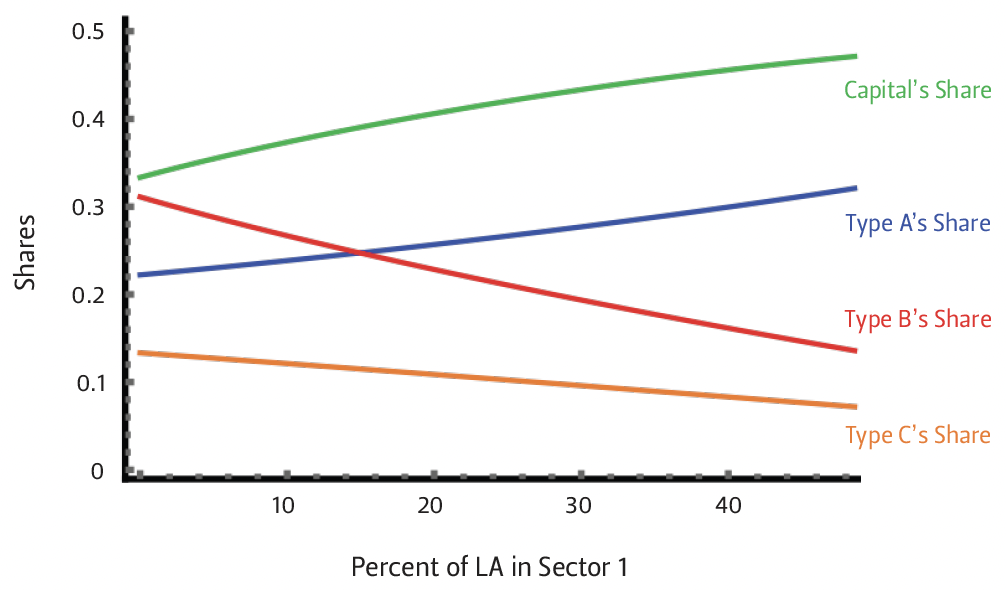
At the endpoint (about 48 percent) of Figure 2, automation has progressed to the point at which displacement of Type B workers is complete, i.e., all Type B workers are employed in jobs where they no longer are in competition with robots. However, automation of jobs held by Type C workers is far from complete. We call the automation region in Figure 2, Case 1. In the extended region (Case 2) in Figure 3, automation of C workers continues. Figure 3 depicts the C.E.S. factor shares over the entire Case 1 plus Case 2 regime.12
Figure 3 — Shares of the Four Factors After Automation Progresses Even Further
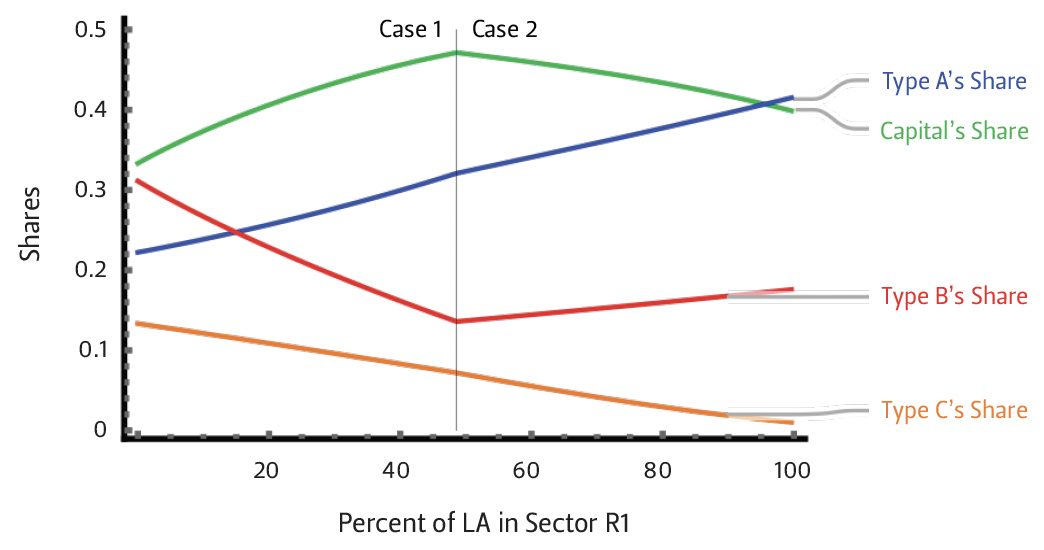
We report Case 2 for completeness. We do not believe that all Type B labor has been or will be replaced in the immediate future. Further, Case 2 is pushing the assumptions of the model beyond what may be reasonable. We used the U.S economy to calibrate the model before the introduction of automation. The production function changes and results that far into the future should be questioned.
Inequality
Type A’s share increases because robots and Type A workers are complements in production. Thus, A’s marginal product increases as more robots are introduced. In Case 1, both Type B and Type C workers are substitutes for robots and their wages decrease because they are linked to robot competition. Thus, the shares of Type B and Type C workers decrease in Case 1. However, in Case 2 with the replacement of Type B workers complete, Type B workers are no longer competing with robots; their wage is no longer tied to Type B robots. They become complements to robots and Type A workers and their wages increase as the number of robots increases. The decrease in capital’s share is caused by the fact that investment in Type B workers is complete. Because the economy is still growing, capital investment continues to grow.
Figure 4 — Growth of Automation as Automation Progresses
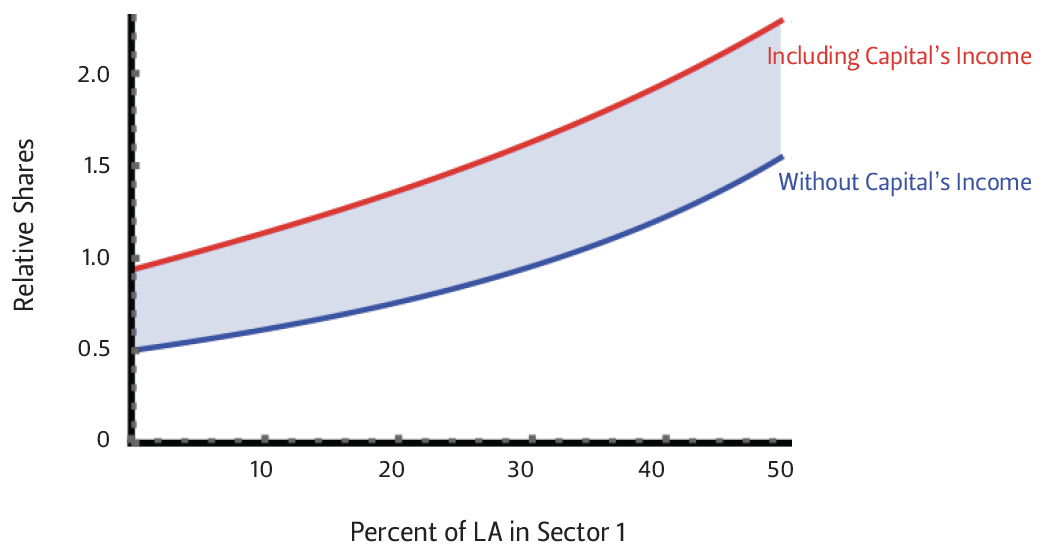
According to Piketty, the top 10 percent of the population owns 80 percent of the capital in the United States.13 This means that if we consider income from capital, inequality is much greater than would be suggested by wage income alone. In Figure 4 below, both the relation of the shares of A workers to the sum of Type B and Type C workers are considered and the relation of the total share of A plus capital are plotted for C.E.S.
At the point of full automation of Type B labor, inequality including capital’s income grows by about a factor of 2.3 from its value near 1 for the automation-free economy.
Welfare
Figure 5 — Effect of Automation Upon Purchasing Power of Labor
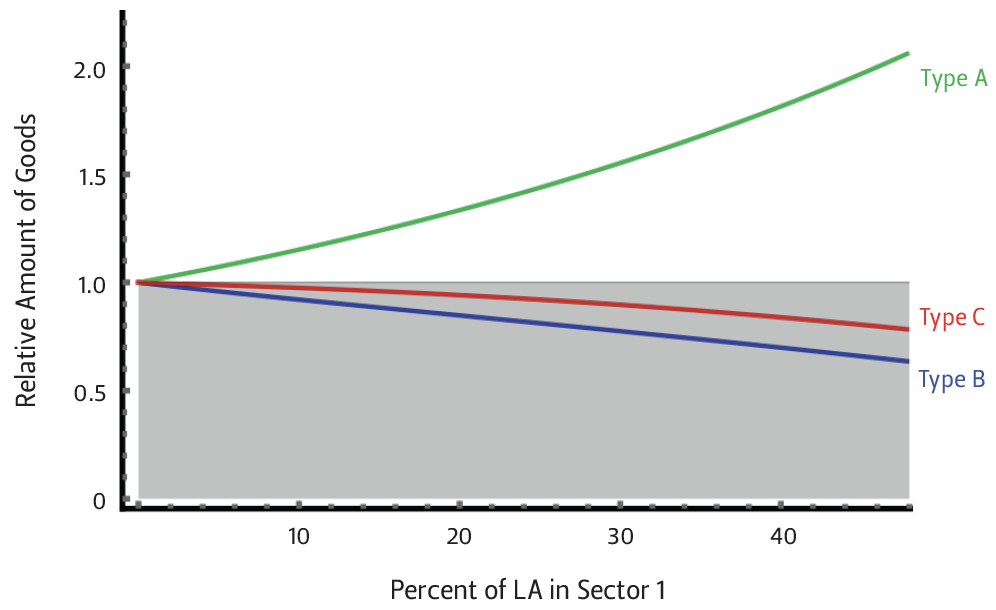
With automation, larger quantities of goods are being produced and their price drops. However, automation results in a decrease in wages for Type B and Type C workers. Can the resulting drop in prices offset the decreased wages of B and C workers? To determine this, we used the Pareto tests: given two allocations, 1 and 2, a person is better off at allocation 2 if he can buy what he bought at allocation 1 with allocation 2 prices and income. Figure 5 demonstrates that neither B or C workers can buy the same package of goods after automation that they could before automation.
Figure 5 alone does not prove that automation is good for A and bad for B and C workers. It could well be that the workers prefer the bundle of goods they bought post-automation to the bundle of goods they bought pre-automation. This test does not address the question of who can pay for the post-automation package of goods under the pre-automation conditions. Figure 6 below shows the fraction of today’s package of goods obtainable at pre-automation prices and wages.
Displacement
The substitution of a worker by automation means that that worker needs to find another job. We study displacement by calculating how many times a worker will lose his/her job as a result of automation. The substitution of B workers is completed in Case 1. Forty-five percent of the tasks of B workers can be automated and, as might be expected, 45 percent of B workers have experienced at least one displacement. Twelve percent have been displaced more than once. Type C workers can be displaced from 80 percent of their tasks, but, in Case 1, only 40 percent of Type C workers experience displacement. By the end of Case 2, 80 percent of Type C workers experience, as expected, at least one displacement.
Figure 6 — Worker's Preference for Consumption Before Automation
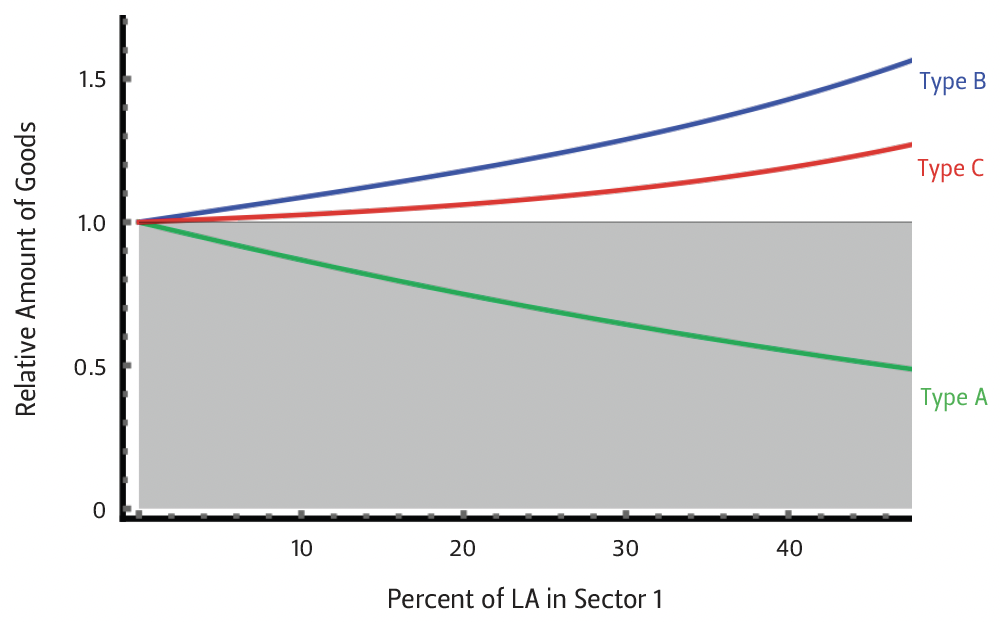
In the later stages of automation, Type C workers, in particular, have a significant chance of experiencing more than one displacement. We imagine being displaced more than once could be traumatic. In our model, we do not try to model the search process in job seeking. Drawing upon the work of other economists who have explored the growth of geographical inequality, we believe that the effects of displacement will depend strikingly upon the area where the displaced worker lives. If local jobs are relatively scarce, the family of the displaced worker typically faces difficult choices. For the two-worker family, the loss of the job of one worker presents the family with particularly difficult decisions because the family still has the income of the other worker. Furthermore, houses are hard to sell in a depressed area. And often in areas where jobs are more plentiful, there are no relatives or close friends to provide social support. Consequently, families are not likely to move from depressed regions to places where jobs are more plentiful. We believe that this problem is creating a serious division of the United States into two nations.
Commentary
Conceptually, one can imagine a model that addresses completely the effects of technical change upon labor, and introduces technical change that augments all classes of labor as well as introduces the creation of new jobs into a formal mathematical model. However, this would result in a model with many as yet unknown parameters. The thought of adding parameters made us recall John von Neumann’s well-known15 remark: “With four parameters I can fit an elephant and with five I can make him wiggle his trunk.” Thus, we believe it necessary for us to make strong assumptions to restrict the number of free parameters.
Before automation had any great impact, management had already found other ways to reduce labor costs. Labor unions were an important factor in creating and maintaining well-paying middle-skilled jobs in the past. When manufacturers moved to states with “right to work” laws, the wage premium attached to manufacturing began to be eliminated. This move of manufacturing south was followed by outsourcing to low-wage countries. These changes have had an enormous impact upon wages in certain sectors. Will the lowered labor costs caused by automation bring manufacturing back to the U.S.? If so, will this result in substantial wage gains for Type B and Type C workers? Our work suggests “no” as the answer to the latter question.
Economists who believe the creation of new jobs driven by new industries will occur base this belief on the historical record that the technologies of the first four-fifths of the 20th century did not result in declining wages as new jobs were created. However, echoing an old refrain, this time may indeed be different. In order to support the notion that new jobs for the middle class and lower class are going to improve their income, it is necessary to try to imagine what tasks can be performed by the displaced workers that cannot be performed by robots. Undoubtedly there will be some, but their accompanying jobs will not be high paying unless they involve abilities that are scarce in the population of displaced workers. If not, the quasi-rents will be eliminated as more workers acquire the necessary skills to compete for those jobs.
The conclusions of this work can be thought of as being very pessimistic. The distribution of income that results from a free market is very unequal. The ratio of the income of the top 10 percent to the bottom 90 percent grows to 3. In 1980 it was 1. The hope that it will be possible to train lower-skilled workers for the high paying jobs of the future is unrealistic. This could be an example of the Paradox of Value. The volume of goods produced by the new technology may be intrinsically very valuable, but unless there is scarcity, their price, and thus the price of their inputs, will not be very high.
The existence of a labor market has more functions than the allocation of labor to the production of goods. At one level it ties the distribution of output to the distribution of factors of production. Eulers Theorem: That the sum of the marginal production of factors times their level in production is equal to output has been used to argue that setting the income of factors to their market wage is fair. Everyone receives what they produce. However, the resulting allocation may not be politically viable and intuitively may seem unfair. The present allocation where the top 10 percent receive considerably more than the lower 90 percent is perceived by many as unfair.
The labor markets have the important function of being the prime incentive for an individual to acquire human capital in the form of an education. Human capital has substantial social externalities beyond providing the skills necessary for a job. One very obvious result of declining human capital is decreasing levels of marriage and with it, the formation of families. There is substantial evidence16 that marriage and the formation of families drops in populations with low levels of education. Adequate parenting is very difficult for a single parent to achieve, but is crucial to the development of the character of the child. Children from low-income populations usually attend schools populated by unmotivated fellow students. This creates a perpetuating cycle of low social mobility. Society suffers from the loss of undetected talent caused by an inadequate school experience. Approximately 70 percent of the children of elites remain elite17 making it necessary for a society to discover replacement talent from the whole.
Endnotes
1. For a complete report of this work see Dagobert Brito and Robert Curl, “Automation Does Not Kill Jobs; It Increases Inequality,” working paper, Rice University’s Baker Institute for Public Policy, July 28, 2020, https://bit.ly/35c2cxK.
2. Adam Smith, An Inquiry into the Nature and Causes of the Wealth of Nations, 1776, public domain in the United States, http://www.gutenberg.org/ebooks/3300.
3. Carl Frey and Michael Osborne, “The Future of Employment: How Susceptible are Jobs to Computerisation,” working paper, Oxford Martin Programme on the Impacts of Future Technology, September 17, 2013, http://www.oxfordmartin.ox.ac.uk/downloads/academic/The_Future_of_Employment.pdf; Carl Frey and Michael Osborne, “The Future of Employment: How Susceptible are Jobs to Computerization,” Technological Forecasting & Social Change 114 (2017): 254–280, DOI: 10.1016/j.techfore.2016.08.019.
4. Until Covid-19, unemployment in the U.S. economy was at record lows.
5. Federal Reserve Economic Data (FRED), “The puzzle of real median household income,” FRED blog, December 1, 2016, https://fredblog.stlouisfed.org/2016/12/the-puzzle-of-real-median-household-income/.
6. Ibid. This is the data of the third graph of the FRED blog (2016) replotted as the lower curve divided by the upper curve.
7. Frey and Osborne, “Future of Employment,” 2013, 2017.
8. Similar calculations were carried out by Philipp Brandes and Roger Wattenhofer. See Philipp Brandes and Roger Wattenhofer, “Opening the Frey/Osborne Black Box: Which Tasks of a Job are Susceptible to Computerization?” arXiv:1604.08823v2[cs. CY], August 31, 2016, https://arxiv.org/pdf/1604.08823.pdf; data: https://disco.ethz.ch/jobs-study.
9. Lawrence Summers and Anna Stansbury, “U.S. workers need more power,” The Washington Post, June 28, 2020, https://www.washingtonpost.com/opinions/2020/06/28/us-workers-need-more-power/.
10. McKinsey & Co., “A Future that Works,” 2017, https://www.mckinsey.com/~/media/McKinsey/Featured%20Insights/Digital%20Disruption/ Harnessing%20automation%20for%20a%20future%20that%20works/MGI-A-future-that-works_Full-report.pdf.
11. We assume that the firms have C.E.S. production functions with an elasticity of 0.5.
12. Automation can continue to progress after there are no more replaceable C workers and there is only one sector. We have chosen not to explore this Case 3.
13. Thomas Piketty, Capital in the Twenty-First Century (Cambridge, MA: Belknap Press, 2014a), http://piketty.pse.ens.fr/en/capital21c2.
14. U.S. citizens own 95 percent of U.S. wealth. The top 10 percent own 80 percent of U.S. wealth so the bottom 90 percent own 19 percent of wealth. See Piketty pp. 156 and pp. 348. The “Including Capital’s Income” line may become steeper because as B and C wages decrease they will be less able to invest.
15. Attributed to von Neumann by Enrico Fermi, as quoted by Freeman Dyson in “A meeting with Enrico Fermi” in Nature 427 (January 22, 2004): 297.
16. Charles Murray, Coming Apart: The State of White America, 1960–2010 (Crown Forum, 2012), ISBN 0307453421.
17. Gregory Clark (and 11 others), The Son Also Rises (Princeton University Press, 2014).
This material may be quoted or reproduced without prior permission, provided appropriate credit is given to the author and Rice University’s Baker Institute for Public Policy. The views expressed herein are those of the individual author(s), and do not necessarily represent the views of Rice University’s Baker Institute for Public Policy.